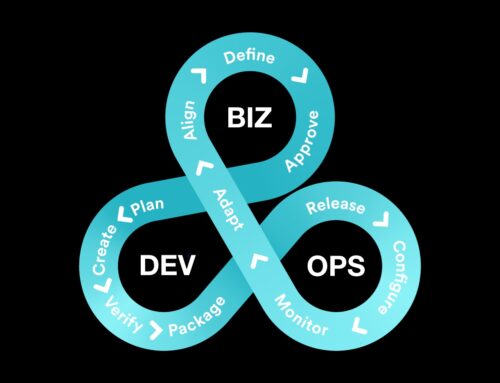The term “DevOps” – a combination of “development” and “operations” – refers to a set of practices that bridge the gap between software development and IT operations. By promoting a culture of collaboration and shared responsibility, DevOps empowers businesses to shorten the software development life cycle and deliver higher quality applications at a quicker pace. DevOps has therefore become an essential component of the IT industry.
But, as with any approach, the key to truly reaping the benefits of DevOps lies in measurement and continuous improvement. That’s where the concept of the “Accelerate” metrics comes into play.
Coined by Dr. Nicole Forsgren, Jez Humble, and Gene Kim in their book “Accelerate: The Science of Lean Software and DevOps,” these four key metrics act as a compass, guiding businesses to assess their DevOps performance objectively. These metrics – Lead Time, Deployment Frequency, Mean Time to Restore (MTTR), and Change Failure Rate – provide a comprehensive picture of a company’s DevOps health, focusing on efficiency, speed, and reliability.
In the fast-paced, highly competitive domain of software development, understanding and optimizing these metrics is essential to standing out in the crowd. By shining a light on where you’re succeeding and where you need to focus your improvement efforts, the Accelerate metrics ensure you’re always progressing on your DevOps journey.
Let’s discuss these metrics and understand why they hold the keys to DevOps success.
The Four Accelerate Metrics
To truly understand the value of the Accelerate metrics, let’s take a closer look at each of them:
1. Lead Time
In the realm of DevOps, Lead Time is the pulse that measures how quickly a team can deliver code from development to production. It’s not just about speed though; it’s about enhancing overall agility and responsiveness to market changes or customer feedback.
For example, if a critical bug fix or a new feature needs to be rolled out, a shorter lead time can make a significant difference. By investing in practices such as Continuous Integration and Continuous Deployment (CI/CD), teams can reduce lead time, making the development process more efficient and seamless.
2. Deployment Frequency
Deployments should be frequent in a high-performing DevOps environment. Why? Because regular deployments mean smaller, manageable changes, leading to lower risk and easier troubleshooting. However, to accomplish a high deployment frequency, it requires a cultural shift and the adoption of certain practices.
Techniques like feature toggles, canary releases, and blue-green deployments can make frequent deployments safer. Automated pipelines and robust testing frameworks are also key in maintaining the balance between speed and stability.
3. Mean Time to Restore (MTTR)
In an ideal world, software failures wouldn’t exist. But, in reality, even the most robust systems can face issues. That’s where MTTR comes in. It measures the efficiency of your recovery strategy post an incident. Lower MTTR signifies quick recovery from failures, thus minimizing the negative customer impact.
Reducing MTTR requires an efficient incident management process, quick and accurate diagnosis, and effective recovery procedures. It’s equally important to learn from each incident to prevent a recurrence, improving your system’s overall resilience over time.
4. Change Failure Rate
Change Failure Rate gauges the reliability of your changes made to production. High Change Failure Rate could indicate issues with testing procedures, release management, or overall software quality. It’s a call for businesses to invest in better testing strategies, more thorough code reviews, and a culture that values quality over quantity.
Reducing Change Failure Rate not only improves stability but also builds customer trust as they experience fewer disruptions.
Collectively, these metrics offer a holistic view of your DevOps performance, focusing not only on speed and efficiency but also on stability and reliability. Mastering them can put your organization on the path to true DevOps excellence.
How MachinesAndCloud Helps in Improving These Metrics
Handling the complexities of DevOps can be a difficult task for many businesses, but MachinesAndCloud has got you covered. We’re committed to driving your DevOps journey to new heights by focusing on optimizing the Four Accelerate metrics.
Shrinking Your Lead Time
With our end-to-end DevOps consulting, we help businesses streamline their software delivery processes. By setting up robust CI/CD pipelines and implementing automation at every step, we’ve been able to significantly reduce the lead time for many of our clients. For instance, “AlphaTech”, a software development company, saw a 40% decrease in their lead time within a few months of working with us.
Boosting Your Deployment Frequency
We believe that more frequent deployments lead to higher agility and lower risk. Our team of DevOps experts will guide you in adopting best practices, such as feature toggles and blue-green deployments, to ensure safe and frequent releases. Our partnership with “BetaCorp”, an e-commerce platform, led to a threefold increase in their deployment frequency.
Reducing Your MTTR
At MachinesAndCloud, we help you create a culture of learning and improvement that embraces failures as opportunities to grow. We facilitate the setup of a proactive incident management system, which significantly reduces MTTR. A case in point is “GammaInc”, a fintech startup. After implementing our suggested incident management system, their MTTR dropped by more than half.
Lowering Your Change Failure Rate
Quality is non-negotiable for us. We help you implement stringent testing strategies and code review processes to reduce the change failure rate. Our focus is to build a system that’s resilient to changes and provides a seamless experience to your customers. “DeltaSolutions”, a healthtech firm, experienced a 30% reduction in their change failure rate after we revamped their testing and release procedures.
At MachinesAndCloud, we believe that a successful DevOps journey hinges on these key metrics. And we’re here to help you navigate this journey, offering expertise and guidance to optimize your processes and unlock the true potential of your business. Contact us to know more..






